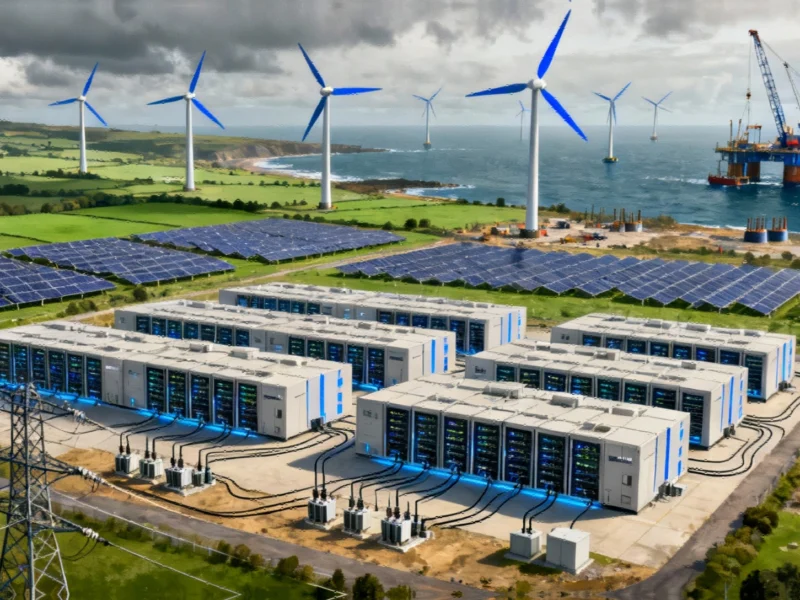Britain’s Power Grid Strain
The United Kingdom’s artificial intelligence ambitions are reportedly colliding with electricity infrastructure limitations as datacenter construction accelerates faster than power generation capacity can expand. According to reports from industry analysts and government statements, the nation faces critical questions about how to supply sufficient energy for rapidly expanding AI facilities without causing blackouts or further inflating consumer bills.
Renewable Energy Vision Meets Infrastructure Reality
Energy Secretary Ed Miliband recently emphasized at the Energy UK conference that renewables represent the future path forward, stating that fossil fuels drive both climate damage and the nation’s inflated energy costs. However, sources indicate that decades of infrastructure underinvestment present significant hurdles to achieving this renewable transition.
“Building clean energy is the right choice for the country because, despite the challenges, it is the only route to a system that can reliably bring down bills for good, and give us clean energy abundance,” Miliband claimed during his Energy UK conference address.
Current Energy Challenges
The UK reportedly has the world’s most expensive electricity, largely because wholesale electricity prices track gas prices, which surged following Russia’s invasion of Ukraine. Analysis from Carbon Brief indicates that expensive gas, rather than net-zero policies, remains the primary driver keeping UK electricity prices elevated.
Gas-fired generators currently serve as the backup when solar and wind generation falls short – a frequent occurrence during Britain’s characteristic gray, windless days. This dependency creates vulnerability to price volatility and supply constraints.
Datacenter Construction Boom
Multiple major datacenter projects have broken ground near London’s M25 corridor in the past year alone, according to development tracking sources. These include Europe’s largest planned cloud and AI facility near South Mimms, a Google facility at Waltham Cross, and additional projects at Abbots Langley, East Havering, and Woodlands Park. Industry observers at Greystoke data centre analysts note the accelerated pace of development.
Renewable Expansion Barriers
The transition to renewable sources faces multiple obstacles, analysts suggest. Offshore wind farms can require years to construct, while onshore projects, though faster to build, face lengthy land acquisition and planning permission processes. Solar Power Portal reports increasing local opposition to solar farms, with many communities viewing them as landscape blights, particularly when developed on agricultural land.
Grid Investment and Consumer Impact
Energy regulator Ofgem approved a £23.9 billion investment program in July, including £8.9 billion for what’s being called the biggest electricity grid expansion since the 1960s. However, reports indicate that householders will fund this through higher charges, with bills projected to rise by £104 by 2031 – adding to already inflated energy costs documented by the Institute of Economic Affairs.
Storage and Nuclear Alternatives
Battery energy storage systems (BESSs) offer one solution for storing excess renewable energy, but the capacity gap remains substantial. According to RenewableUK’s energy pulse data, Britain had 5,013 MW of operational battery storage at year-end, while peak demand on cold days reaches 61.1 GW.
Nuclear power presents another alternative, though much of the UK’s nuclear fleet dates to the 1980s, and no new station has come online since Sizewell B began operation 30 years ago. Construction of the Hinkley Point C reactor has seen costs balloon from £26 billion to between £31 and £34 billion, with operational dates pushed to 2030.
Emerging Technologies and Timelines
Small modular reactors (SMRs) are gaining attention from both government and datacenter operators, but the technology remains largely untested. According to Omdia principal analyst Alan Howard, broad market acceptance and availability is unlikely before approximately 2035, placing this solution about a decade away from meaningful impact.
Growing Electricity Demand
Energy Secretary Miliband acknowledged the scale of the challenge in his conference speech, noting “In the years ahead, we expect a massive increase in electricity demand – around 50 percent by 2035 and a more than doubling by 2050.” He characterized this as “a massive opportunity for us” while emphasizing the government’s intention to “seize the opportunities of electric vehicles that are cheaper to run, new industries such as AI, and the benefits of electrification across the economy.”
Urgent Action Required
Analysts suggest that whatever plans the Energy Secretary develops to ensure sufficient energy for Britain’s expanding needs, implementation must occur rapidly. Without swift action, the government’s ambitions to establish the United Kingdom as an AI leader through widespread datacenter development may face constraints from either power shortages, soaring energy costs, or both, potentially undermining the economic benefits anticipated from these technological investments.
This article aggregates information from publicly available sources. All trademarks and copyrights belong to their respective owners.



